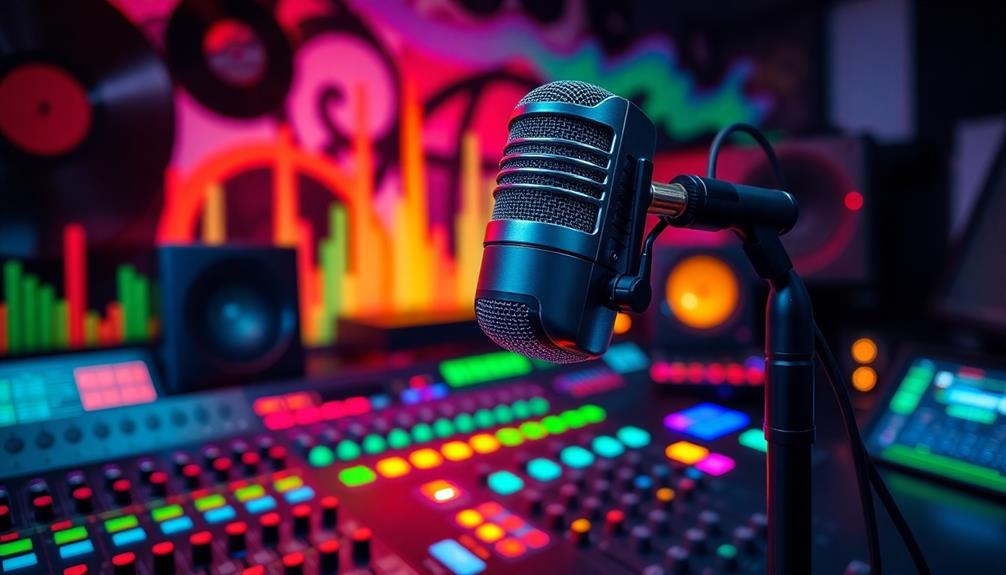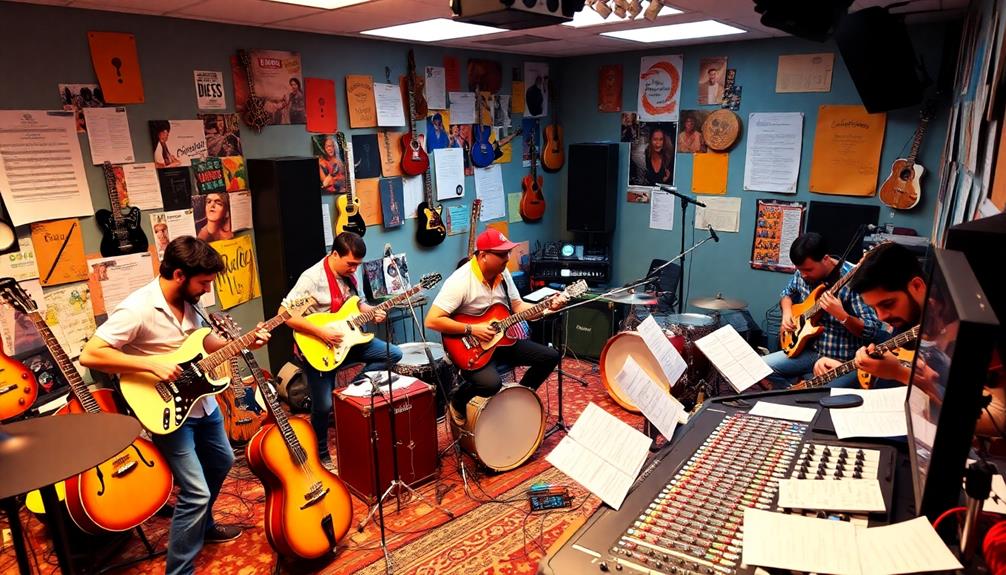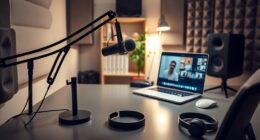To make your vocals shine, start with clear track organization and clean up any noise. Use high-pass filtering to remove unwanted low-end frequencies, and apply gentle compression to keep dynamics in check. Experiment with EQ boosts in the 3-5 kHz range for clarity while maintaining the natural timbre. Don't forget to implement creative effects like vocal doubling and modulation to add depth. Balance your vocals within the mix, using reverb and delay for spatial enhancement. Master these techniques, and you'll elevate your mixing game considerably. Keep going, and you'll discover even more pro tips!
Key Takeaways
- Use high-quality microphones and audio interfaces to capture vocals accurately and enhance overall fidelity in the mix.
- Implement double tracking and panning techniques to create a fuller, richer vocal presence and widen the stereo image.
- Employ careful EQ to cut problematic frequencies and boost presence, ensuring clarity and maintaining the natural timbre of the vocals.
- Apply gentle compression and consider parallel compression to control dynamics while preserving vocal expressiveness and punch.
- Experiment with creative effects like saturation and modulation to add warmth and depth, making the vocals stand out in the mix.
Preparation for Mixing Vocals
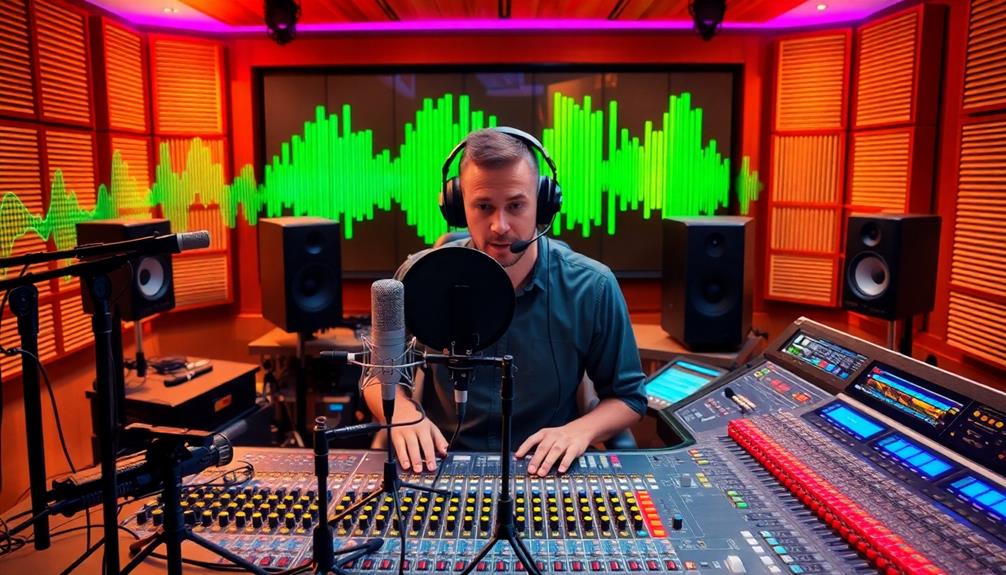
When preparing to mix vocals, it's vital to set yourself up for success right from the start. Begin by organizing your vocal tracks in your DAW. Clearly label each track to facilitate easy access and avoid confusion during the mixing process.
Once that's done, you need to clean up the vocal. Remove unwanted background noise, clicks, and artifacts to guarantee a pristine sound.
Next, comp the best takes from your initial recordings. This means selecting the strongest performances and confirming each section aligns perfectly with the instrumental track for a cohesive sound.
It's important to maintain the vocals' natural character, so while you manage breath sounds, keep the natural breaths but lower their volume if they stand out too much. This approach helps preserve an authentic vocal feel.
Vocal Enhancement Techniques
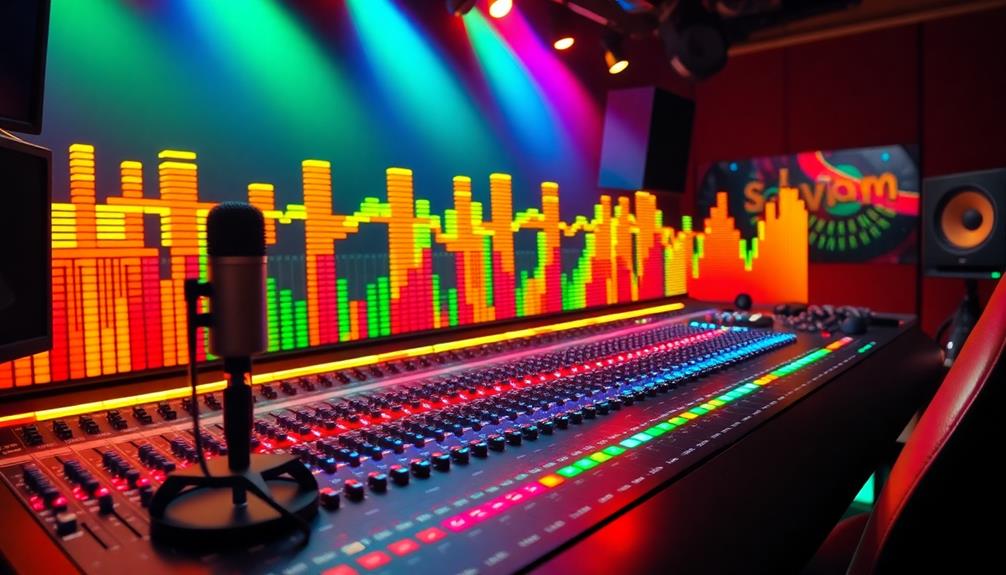
To truly elevate your vocals, consider upgrading your vocal chain with quality plugins that enhance clarity and presence.
Double tracking your vocals can add depth, making them more engaging in the mix.
Additionally, using exciters and enhancers can bring brightness to your vocals, helping them stand out without sounding harsh.
Upgrading Vocal Chain
Upgrading your vocal chain can transform your recordings from ordinary to extraordinary. By investing in high-quality microphones and audio interfaces, you'll considerably enhance the clarity and fidelity of your vocal recordings. This solid foundation is essential for effective mixing, as it allows for better integration with advanced AI-driven solutions for audio processing AI-driven solutions.
Start with a microphone that captures your voice accurately and colorfully. Pair it with a superior audio interface to guarantee your signal maintains integrity during the recording process. This setup will allow your vocals to shine and cut through the mix with precision.
As you refine your vocal chain, consider utilizing fast, aggressive compression settings to control dynamics, especially in genres like rap. This technique provides a punchy, upfront presence, guaranteeing your vocals stand out.
Don't forget about high-pass filtering; removing unnecessary low-end frequencies above 1kHz will yield a cleaner sound, allowing other instruments to shine.
Double Tracking Techniques
Double tracking is a powerful technique that can often elevate your vocal recordings by adding richness and depth. By recording the same vocal part multiple times, you introduce subtle variations in pitch and timing that create a fuller sound.
Here are three key strategies for effective double tracking:
- Vary Your Performance: Aim for slight differences in each take. This natural variation enhances the overall vocal presence when blended together.
- Use Panning Techniques: Place one vocal take slightly left and the other slightly right. This widens the stereo image and makes the vocals stand out in the mix.
- Experiment with EQ and Compression: Apply different EQ and compression settings to each track. This not only provides unique textures but also helps prevent phase issues that can muddy your mix.
Additionally, don't overlook microphone placements for each take. Experimenting with different positions can lead to a more dynamic and engaging vocal sound, ultimately adding to the richness of your mix.
With these double tracking techniques, you'll create vocals that truly shine and resonate with your audience.
Exciters and Enhancers
Exciters and enhancers can transform your vocal tracks, giving them the brightness and definition they need to stand out in a mix. By introducing harmonic content, these tools enhance vocal clarity and presence, especially in critical frequency ranges like 3-5 kHz.
Using an Aural Exciter as a send effect allows you to add subtle enhancements without overwhelming the original signal, creating a richer, more engaging sound.
When applying saturation, controlling the amount is key to avoid unwanted distortion. A little warmth can greatly enhance listener engagement while preserving the integrity of your vocals.
Experimenting with different exciters, particularly analog-modeled plugins, can yield unique textures and add character to your vocal processing.
Focus on the natural timbre of your vocals as you adjust these effects. By targeting specific frequency ranges, you'll guarantee that the enhancements you introduce complement the vocal's inherent qualities, rather than overshadow them.
EQ and Compression Strategies
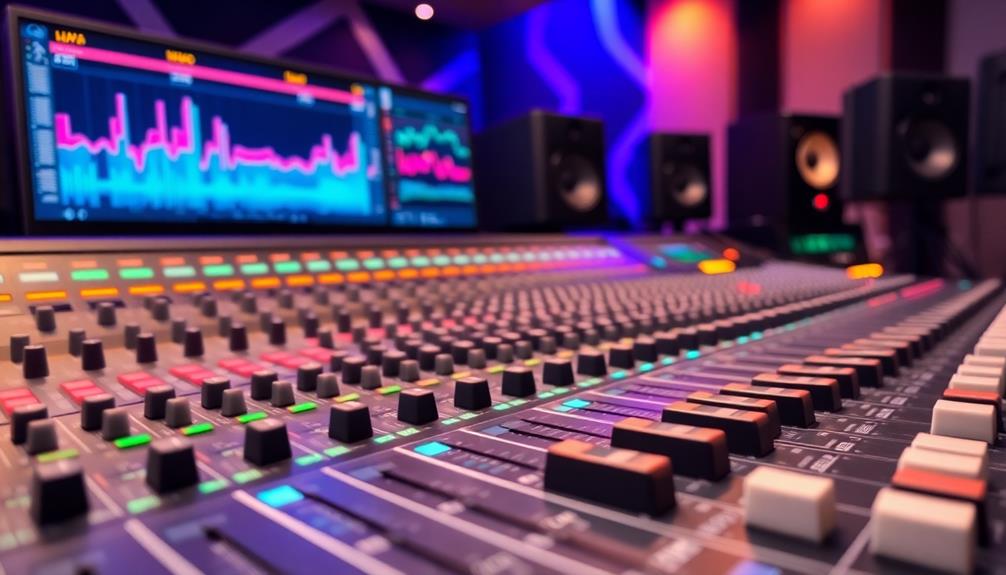
When mixing vocals, mastering EQ and compression techniques can make all the difference in achieving a polished sound. Here are three strategies to elevate your vocal tracks:
- High-Pass Filtering: Start by implementing high-pass filtering around 60-90 Hz. This removes low-end rumble, enhancing vocal clarity before you make any other EQ adjustments.
- Subtractive EQ: Next, utilize subtractive EQ to cut problematic frequencies, especially in the 200-400 Hz range. This helps reduce muddiness and improves overall vocal presence.
- Compression Techniques: When applying compression, aim for a gentle ratio of 2:1 to 4:1. Adjust your attack and release settings to preserve the vocal's natural characteristics while controlling vocal dynamics.
You can also experiment with parallel compression, blending a heavily compressed signal with the original to boost loudness and presence without sacrificing dynamic range.
Reverb and Delay Techniques

When mixing vocals, getting your reverb settings right is essential for maintaining presence without cluttering the mix.
You can enhance your sound by exploring different delay types, which can thicken tracks or add rhythmic flair.
Let's look at how to optimize these effects for a polished vocal performance.
Optimal Reverb Settings
Achieving the perfect vocal sound often hinges on your reverb settings, which can transform a flat performance into a lush experience. Here are three key strategies to optimize your reverb for vocals:
1. Choose Plate Reverb: Start with a plate reverb, setting your decay times between 0.5 to 1 second. This adds brightness and splashiness without overwhelming your mix.
2. Set Pre-Delay and Diffusion: Maintain vocal clarity by adjusting the pre-delay to 20-50 milliseconds. This allows your reverb to create depth while keeping the vocal upfront.
Experiment with high diffusion settings (50% or higher) to enhance the vocal presence and achieve a denser sound.
3. Balance Wet and Dry Signals: For a balanced spatial effect, consider using a combo of small room reverb and plate reverb. This approach adds warmth without muddying vocals.
Regularly adjust reverb parameters based on the performance and genre to guarantee the wet signal complements the dry signal, enhancing clarity and emotional impact.
Delay Types Overview
Delays play an essential role in shaping the atmosphere and depth of a vocal track. Utilizing various types of delay can enhance your mix, adding richness and rhythmic interest. Here's a quick overview of effective delay techniques:
| Delay Type | Description |
|---|---|
| Tape Delay | Emulates analog warmth and saturation. |
| Digital Delay | Offers precise timing and clarity for modern mixes. |
| Ping-Pong Delay | Alternates signals between left and right channels, creating spatial interest. |
| Ducking Delay | Lowers the delayed signal when vocals are present, keeping them clear and prominent. |
When setting the delay time, consider using quarter or eighth notes to complement the vocal phrasing and enhance the overall groove. Adjusting feedback control is vital; too much can muddy your mix, while too little may lack presence. The right delay effect can create engaging echoes that enhance your vocal track without overwhelming it. By mastering these delay techniques, you'll find the perfect balance, ensuring your vocals shine brightly in the mix while maintaining their clarity.
Vocal Treatment Essentials
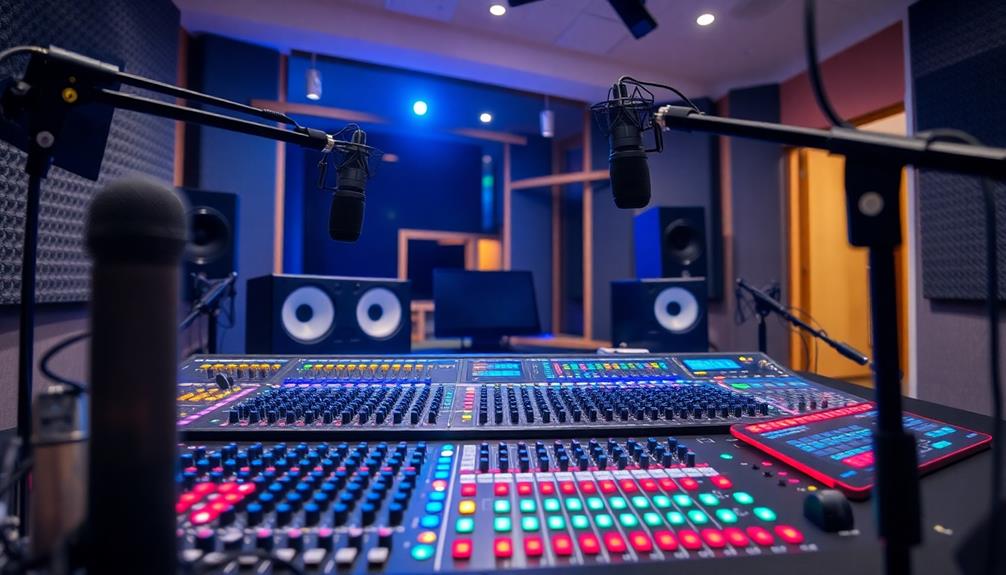
Vocal treatment is vital for achieving a polished mix that highlights the singer's performance. By focusing on key techniques, you can guarantee your vocals sound professional and vibrant. Here are three important elements of vocal treatment:
- High-Pass Filtering: Use high-pass filtering around 60-90 Hz to eliminate low-end muddiness. This step clears the way for a more pronounced vocal sound in your mix.
- Pitch Correction: Employ pitch correction tools like Melodyne or Auto-Tune with slow retune speeds. This maintains the natural quality of the vocal while addressing any intonation issues.
- Compression and EQ: Apply gentle compression with a ratio of 2:1 to 4:1, adjusting the attack and release to preserve the vocal's dynamic range.
Utilize subtractive EQ to cut problematic frequencies in the 200-400 Hz range, and boost presence frequencies around 3-5 kHz for enhanced clarity.
Don't forget to use de-essers to target sibilance between 5 kHz and 10 kHz, guaranteeing the vocals are clear without sounding overly processed.
Common Mixing Tools
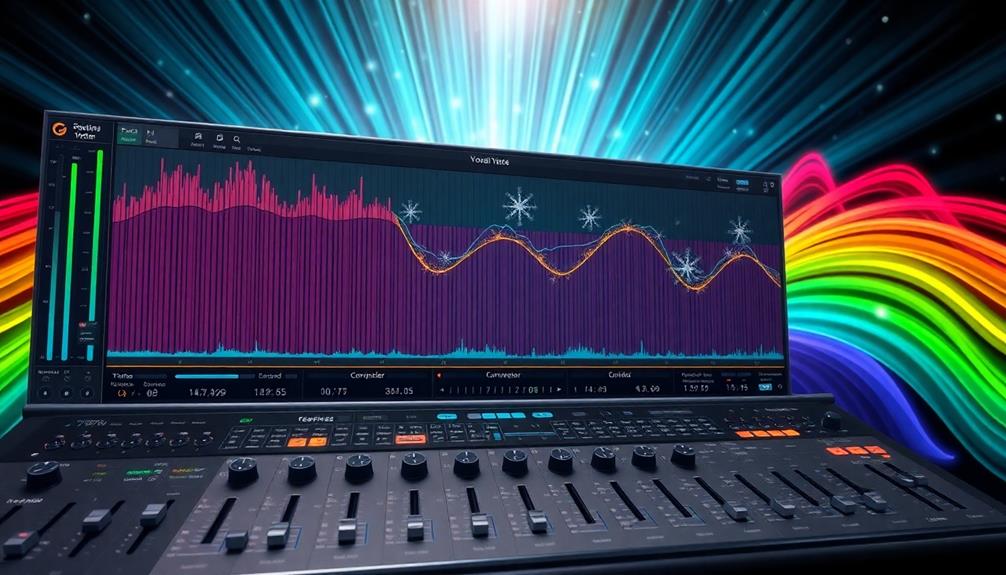
When it comes to mixing vocals, having the right tools at your disposal can make all the difference. Digital audio workstations (DAWs) like Ableton Live, Pro Tools, and Logic Pro are fundamental for managing your vocal tracks and organizing sessions. They provide intuitive interfaces that streamline the mixing process.
One of the most important tools you'll use is a compressor. Compressors help achieve dynamic control by reducing the dynamic range, ensuring consistent vocal levels. Popular choices like the 1176 and LA-2A add unique character and sound shaping to your mix.
Equalizers (EQ) are equally essential for frequency shaping. They allow you to remove unwanted frequencies and enhance vocal clarity, with high-pass filters effectively eliminating low-end rumble.
Don't forget about reverb, which creates spatial effects and depth in your mixes. The type of reverb you choose—be it plate or hall—will depend on the genre and desired atmosphere.
Finally, de-essers are crucial for managing harsh sibilance, targeting frequencies between 5kHz and 10kHz to improve overall clarity and listener comfort.
With these tools, you'll be well on your way to achieving professional-sounding vocal mixes.
Finalizing the Vocal Mix
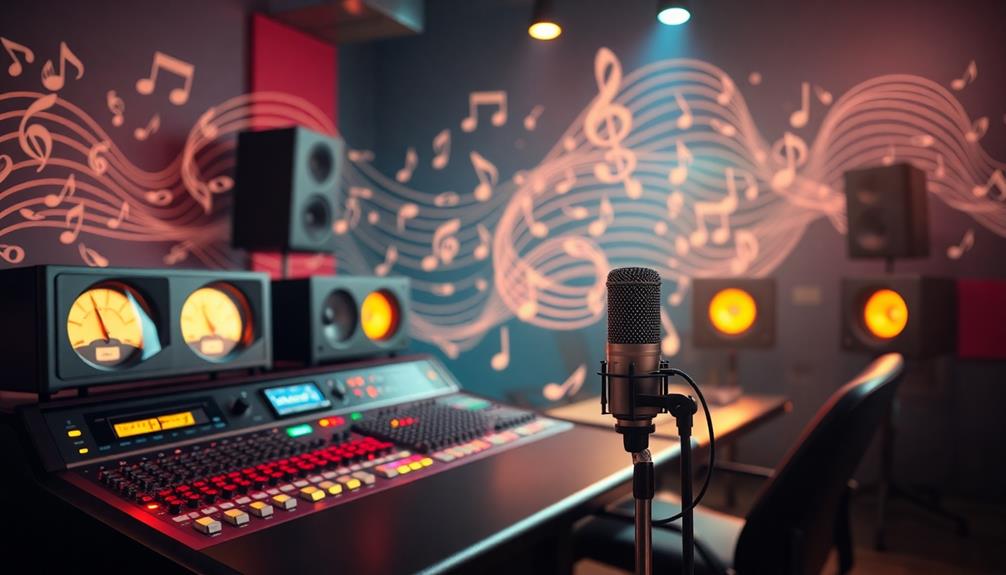
To achieve a polished and cohesive vocal mix, start by conducting critical listening tests on various playback systems. This guarantees your vocal mix translates well across different environments and highlights any imbalances.
Here are three key steps to finalize your vocal mix effectively:
- Balance Levels: Make sure your lead vocals sit well within the mix, maintaining a natural sound that doesn't overpower the instrumentation or background vocals.
- Seek Feedback: Gather insights from peers or industry professionals. Their feedback can help refine the mix, enhancing clarity and presence in your vocal performance.
- Final Tweaks: Focus on EQ and dynamics to guarantee each vocal element contributes effectively to the overall emotional impact of the track.
Once you're satisfied, export your mix in high-quality formats and document your settings and processes. This documentation will aid consistency in your workflow for future projects.
Creative Vocal Effects

Exploring creative vocal effects can greatly elevate your mix and fascinate listeners. One effective technique is vocal doubling; by recording the same part multiple times with slight variations in timing and pitch, you create a thicker, more natural sound that enhances the richness of your vocals.
Additionally, leveraging AI-powered virtual reality in e-learning can provide unique insights into sound design and mixing techniques.
Don't shy away from incorporating modulation effects like chorus or flanging, which add depth and movement to your performances, making them more engaging. Creative pitch shifting can also emphasize specific words or phrases, introducing unique textures that evoke emotional responses from your audience.
Additionally, applying saturation to your vocals brings subtle harmonic distortion that enhances warmth and presence without drowning out the original sound, keeping your mix engaging.
Finally, explore advanced reverb techniques. By blending different types of reverb, such as plate and hall, and adjusting pre-delay settings, you maintain clarity while adding a sense of space and dimension to your vocal mix.
These creative effects not only enhance your vocals but also contribute to a fascinating listening experience that resonates with your audience.
Frequently Asked Questions
How to Add Shine to Vocals?
To add shine to vocals, you can boost around 3-5 kHz with EQ, apply fast compression for clarity, and use subtle saturation. Experiment with doubling and short reverb to create depth and enhance presence.
How Do You Mix Vocals for Clarity?
Mixing vocals for clarity requires balancing warmth and brightness. You'll use high-pass filters to eliminate muddiness while enhancing presence. Compression smooths fluctuations, and de-essing tames harshness, ensuring your vocals shine through in the mix.
How Do I Get My Vocals to Sit Better in the Mix?
To get your vocals to sit better in the mix, clean unwanted noise, use a high-pass filter, compress consistently, apply EQ for brightness, and add subtle reverb for depth without losing clarity.
How Do You Polish Vocals?
Perfectly polished vocals require precise processing. Start with high-pass filtering to remove rumble, then control dynamics with gentle compression. Enhance brightness using EQ, and finally, add depth through reverb and delay for a mesmerizing vocal presence.
Conclusion
By following these advanced mixing tips, you'll turn your vocals into shimmering gems that captivate listeners like a siren's song! With the right techniques, your tracks won't just shine—they'll explode with clarity and emotion, soaring above the rest like a rocket in a fireworks show. So grab your tools, release your creativity, and watch as your mixes transform into masterpieces that'll leave everyone breathless. Your vocals deserve to be the stars of the show—let them shine! Don’t settle for mediocrity when you can elevate your tracks with vocal production masterclass techniques that unlock their full potential. Experiment with dynamic EQ, precise automation, and creative effects to craft a sound that’s uniquely yours. Remember, every detail you polish brings you closer to creating mixes that not only sound professional but evoke powerful emotions in your audience.

